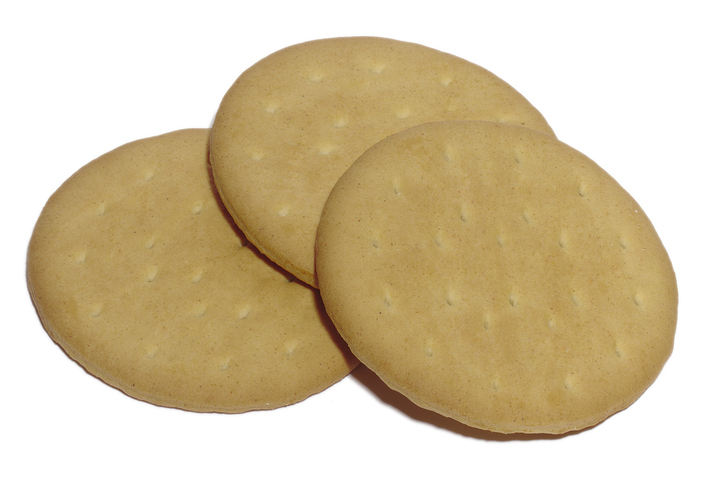Bourbons, shortbreads, digestives, oh my! Biscuits might be bite-sized, but their legacy is anything but small. From ancient grainy slabs to chocolate-covered classics, these humble bakes have risen through the ranks – nourishing Neolithic travellers, delighting Georgian tea parties, and conquering supermarket shelves in every corner of the globe.
Whether crisp and crumbly or soft and sandwiched, each biscuit tells a tale of time, taste, and sometimes, technological triumph. Ready to dunk into the delicious history of the world’s most iconic biscuits? Let’s crack on.
1. Digestive Biscuit

The classic chocolate digestive biscuit (Credit: lleerogers via Getty Images)
Invented by Scottish doctors in 1839, the digestive biscuit was originally intended as a health food to “aid digestion.” Despite these early marketing efforts, there proved to be little scientific evidence to back up the claim, but the name endured – and so did the biscuit. The key ingredient? Baking powder. This simple leavening agent was believed to neutralise stomach acid and guard against indigestion. And thus the digestive was born.
With its lightly sweet, oaty texture, the digestive soon became a household essential – perfect for cheese, tea-dipping, or the classic 4pm snack. With its hearty, wheaty texture and gentle sweetness, the digestive has risen to become one of Britain’s favourite biscuit tin tenants. In fact, the chocolate-coated variety alone shifts around 70 million packets each year.
2. Bourbon

Bourbon biscuits (Credit: etienne voss via Getty Images)
What do a biscuit from Bermondsey and an American whiskey have in common? They’re both named after the French royal house of Bourbon. Yet the Bourbon, with its two cocoa biscuits sandwiched with chocolate buttercream, is as British as drizzle.
Created in 1910 by confectionary company Peek Freans, they were originally called Creola. It’s unclear what led to their rebranding in the 1930s, although it’s thought the new name was chosen for sounding refined. Beloved by generations, the Bourbon’s allure lies in its perfect dunking durability and that satisfying filling-to-crunch ratio.
3. Shortbread

Scrummy Scottish shortbread (Credit: JamieRogers1 via Getty Images)
Shortbread has a long and delicious history dating back to 12th-century Scotland, originating from a practical “biscuit bread,” baked twice from leftover dough sweetened for flavour. Gradually, bakers substituted leavening ingredients with generous amounts of butter, producing its uniquely crumbly texture – known to bakers as “shortness.”
Initially considered a luxurious treat, shortbread was reserved exclusively for festive occasions such as weddings and celebrations. Moreover, Mary, Queen of Scots, famously adored shortbread, particularly the delicately shaped ‘Petticoat Tails’.
Today, shortbread retains its classic forms – neatly segmented rounds, elegant wedges, or practical fingers – remaining a timeless favourite, enjoyed not only for its buttery taste but also for its rich, historical charm.
4. Gingerbread

Gingerbread houses (Credit: FXQuadro via Getty Images)
It’s shaped into people and houses, has an inextricable link with Christmas, and plays a starring role in more than one fairy tale. And that’s just the more recent history of gingerbread; a history that goes back to Classical times.
But gingerbread as we know it originated around the 11th century, when the Crusaders introduced ginger and other spices to Europe. It was quickly embraced and spread. By the 15th century, the English viewed gingerbread as synonymous with fairs, where they were cut to form animals, flowers and more. Known as “fairings,” these biscuits were given as tokens of luck.
By the time Elizabeth I took the throne in 1558, the spicy biscuits were well known. However, the Tudor queen is said to have popularised forming gingerbread into “men,” specifically serving them in the likeness of visiting dignitaries.
As for gingerbread houses, these originated in Germany. Many point to the 19th century Grimm brothers’ story Hansel and Gretel with its witch’s house as the inspiration. Others argue that the practice dated back centuries earlier. Incidentally, the original witch’s cottage was not made of gingerbread, but bread and sugar decorations.
5. Rich Tea

Rich Tea - the legendary dunker (Credit: rgbdigital via Getty Images)
The Rich Tea is a biscuit that knows its place, and wears it well. It’s the polite guest at the biscuit table: mild-mannered, non-crumbly, and just sweet enough. Invented by 19th-century Yorkshire bakers for the upper classes, it was originally enjoyed during afternoon tea.
Its true genius, though, lies in its perfect tea-dunking form. Give it a quick dip, and it softens just enough without collapsing – unless you’re distracted mid-dunk, in which case, good luck fishing it out.
6. Garibaldi

A stack of Garibaldi biscuits (Credit: exopixel via Getty Images)
Also known as the ‘squashed fly’ biscuit (affectionately, we promise), the Garibaldi was introduced in 1861 by Peek Freans in honour of Italian revolutionary Giuseppe Garibaldi’s visit to Britain. Between two thin layers of dough lies a bed of chewy currants – simple, sturdy, and oddly satisfying.
It may not win awards for glamour, but it’s a workhorse of the biscuit world. Portable, unfussy, and usually healthier than its cream-filled cousins.
7. Custard Cream

Custard Creams - a plateful of perfection (Credit: Yoyochow23 via Getty Images)
First crafted in 1908, the custard cream has become a lunchtime legend. With its ornate baroque-style design and buttery vanilla filling, it’s equal parts elegance and indulgence.
The name nods to the custard-flavoured centre – though technically, there’s no custard in sight. Instead, the filling is typically a vanilla-flavoured cream that mimics the taste of custard without containing any of its traditional ingredients.
It’s been voted Britain’s favourite biscuit more than once, and with good reason. If you’re a break-apart then consume sort of person, you’re in good company.
8. Anzac Biscuit

Delicious Anzac biscuits (Credit: 11Audrey11 via Getty Images)
With deep roots in the history of Australia and New Zealand, the Anzac biscuit is more than a sweet treat – it’s a symbol of remembrance. These oat-and-coconut biscuits were sent to soldiers during World War I due to their long shelf life and resilience, becoming a source of comfort from home. They’re still baked every April 25th for Anzac Day, carrying the weight of history and heart in every bite.
9. Oreos

Oreos, Oreos, everywhere... (Credit: Burke/Triolo Productions via Getty Images)
No list of famous biscuits could ignore the Oreo. First introduced in 1912, the Oreo ranks among the world’s bestselling cookies (yes, we’ll allow the term just this once). Its black-and-white look is instantly recognisable, and the filling has sparked everything from YouTube challenges to academic studies on biscuit engineering.
10. Marie Biscuit

Mmmmm, Marie biscuits! (Credit: vasantytf via Getty Images)
First baked in 1874 to commemorate the wedding of Grand Duchess Maria Alexandrovna of Russia and the Duke of Edinburgh, the Marie biscuit was Britain’s diplomatic gesture in baked form. What began as a ceremonial treat soon became a pantry staple across Europe, South America, and Asia.
Mild, sweet, and endlessly dunkable, the Marie biscuit is anything but plain. Whether layered in no-bake desserts or paired with tea, its soft snap and subtle vanilla taste offer a reliable comfort that transcended borders.
Final Crumbs

Crisp, crumbly cookies! (Credit: Jarana Creatives via Getty Images)
From medicinal ambitions to monarchic weddings, the humble biscuit has been anything but ordinary. These ten treats – whether crisp, crumbly, cocoa-filled or currant-stuffed – have each left their own buttery stamp on history. They’ve travelled across continents, sweetened sombre moments, and sparked feuds over the biscuit tin. Some began as status symbols, others as survival snacks, yet all of them have become household staples in their own right.
So next time you’re dunking a Rich Tea or sneaking a midnight Bourbon, remember: you’re not just tasting a snack – you’re partaking in a centuries-old tradition of comfort, creativity, and a fair bit of crunch.












